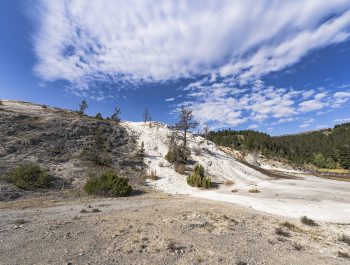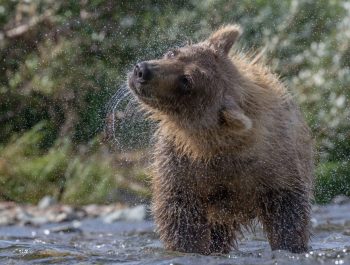Monsoon Clouds
Dramatic Skies Part II
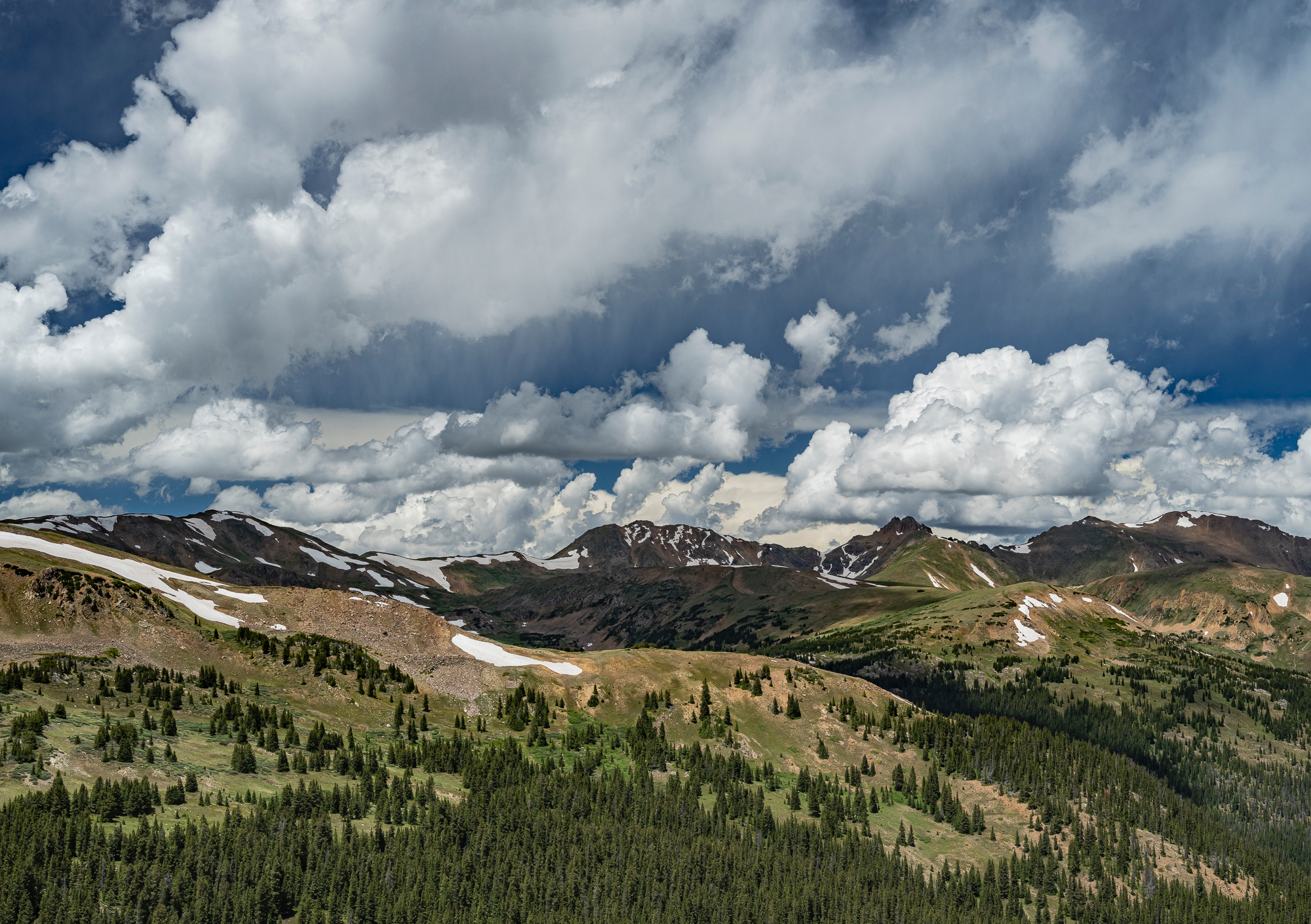
On October 25, 2019, PhotoPXL.com published an article of mine entitled “Dramatic Skies for More Compelling Landscapes”. I thought that it pretty much covered the subject, including monsoon clouds, and didn’t require a follow-up. The summer months of 2022 dramatically refuted that, for we had the best monsoon season that I’ve experienced in the past 20 years.
I think that readers will enjoy the following images as they are certainly dramatic. First, a brief description of what constitutes the American Monsoon weather pattern will be helpful.
American Monsoon Weather – What, Where, When & Why
In terms of annual rainfall, the American Southwest – primarily Arizona and New Mexico – is some of the driest land areas in the United States as suggested by annual rainfall. Given that, it is startling to realize that 70% of annual rain in those two states occurs in the months of July, August, and September. In other words, almost three-quarters of the annual rain in this region falls during one quarter of the year. And as might be expected, these are months of thunderstorms that deliver intensive rainfall.
June is one of the hottest and driest months of the year. But this heat causes the American Southwest, northwestern Mexico, and the California Gulf and the adjoining Pacific Ocean to heat up and inject huge amounts of moisture into the regional atmosphere creating a high-pressure zone that changes the prevailing westerly wind pattern to a southerly one. This initiates a pattern of intense cloud buildup moving north and dropping copious rain which temporarily cools the region down thereby diminishing storm activity until a new heating cycle drives another round of moist air northward. This pattern is widely known as the American Monsoon Season.
The stratocumulus clouds that are formed at this time are huge and turbulent. Aside from their immense power, they are also visually striking, particularly in the mid-to-late afternoons when they are most likely to generate thunderstorms. The southerly winds that push these clouds north deliver rain not only to Arizona and New Mexico, but also to Utah and Colorado, including the southern Rocky Mountains.
The combination of monsoon skies with either mountains or red-rock canyon land provides some of the most dramatic and unique landscape tableaus in the country. Following are 18 images that I captured this summer of 2022.
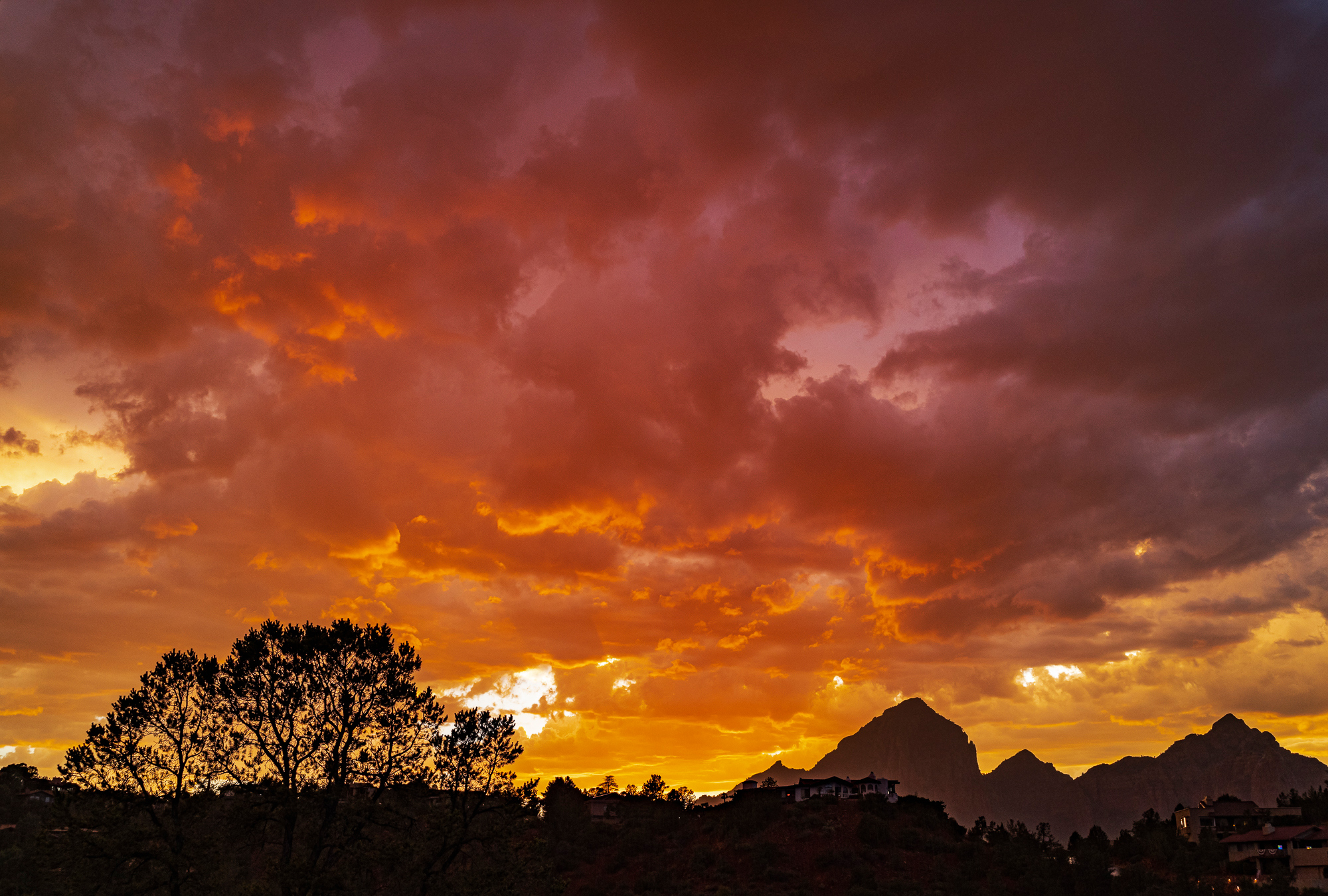
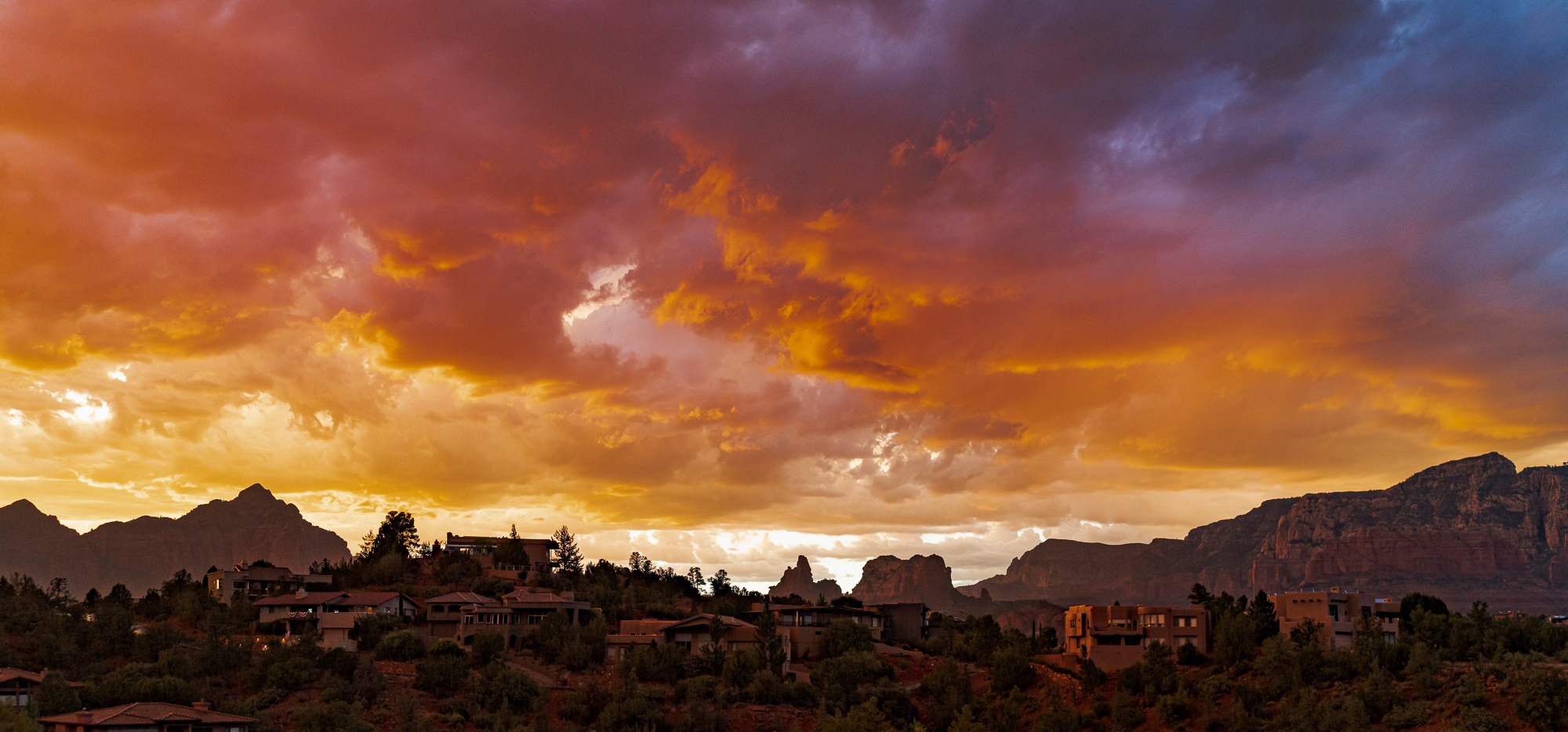
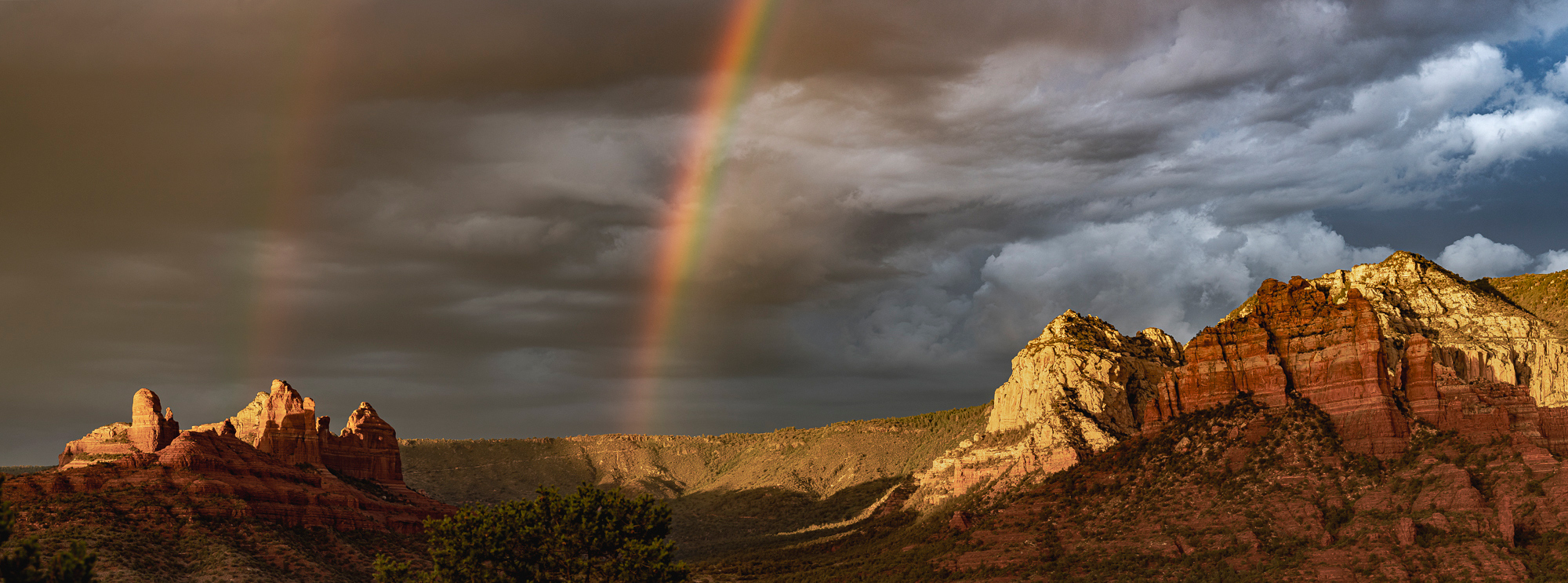
The three images above were taken on June 23, 2022, after the first thunderstorm of the Monsoon Season. This was about ten days earlier than usual, most likely because the preceding weeks were hotter in the Southwest than in most years. The long-range forecast was for a stronger monsoon effect with greater than average rainfall.
As we moved through the Summer, not only were the storms occurring more regularly than in recent years, but they lasted longer, often clearing just before sunset and creating dramatic sunsets. Moreover, strong wind shear typical of higher energy storm fronts produced more unusual cloud formations that added additional drama as seen in the next three images.
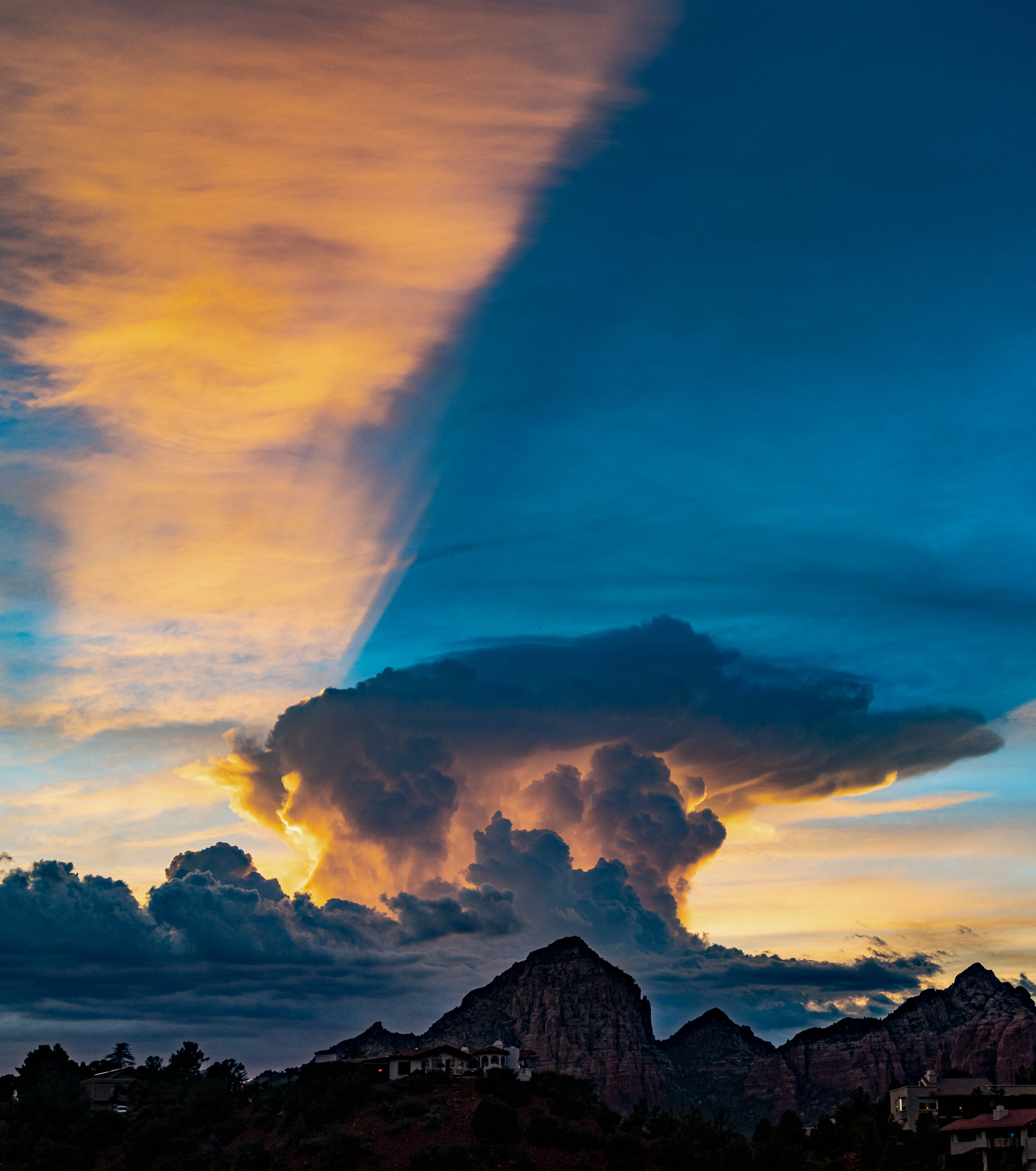
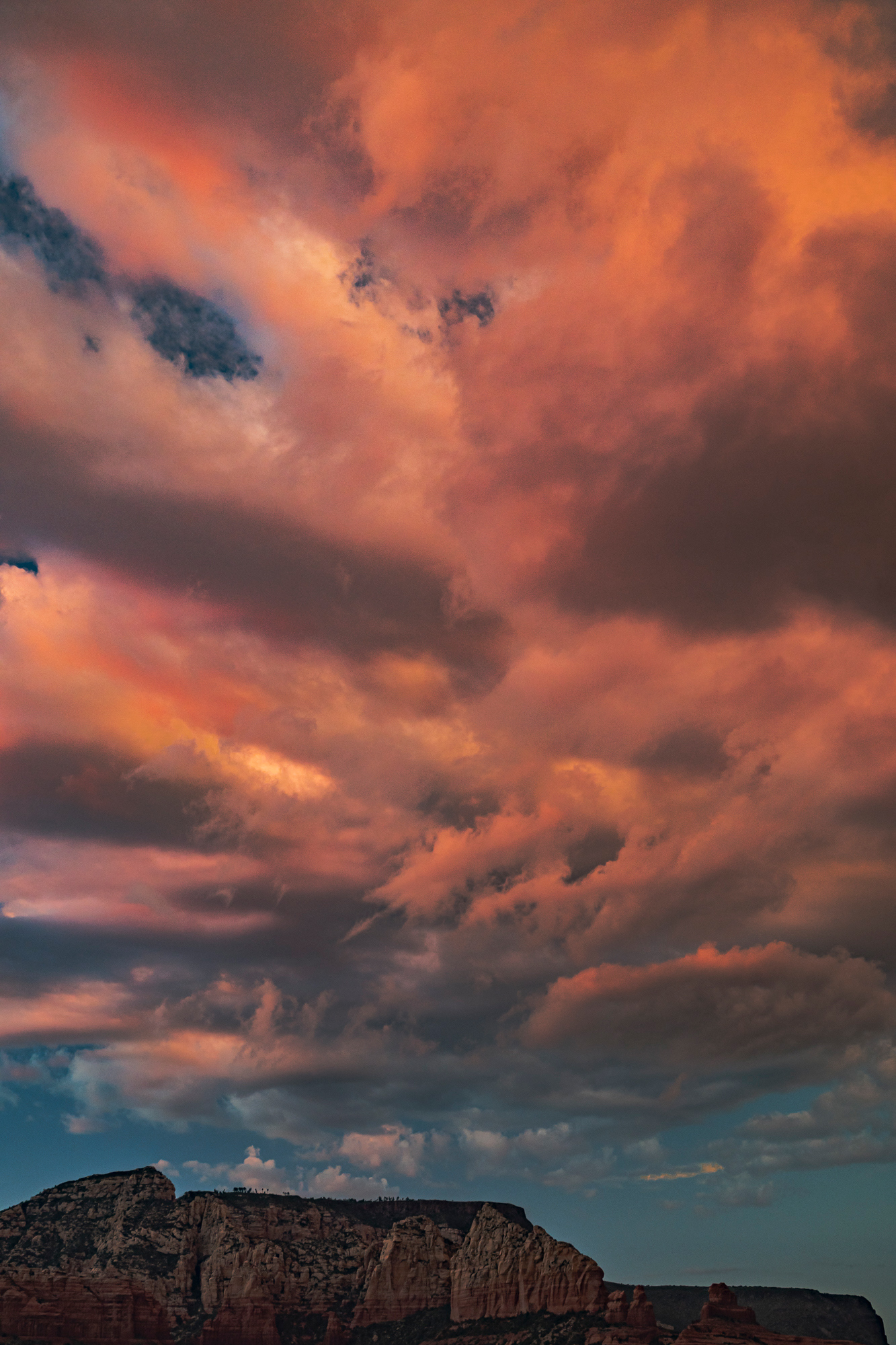
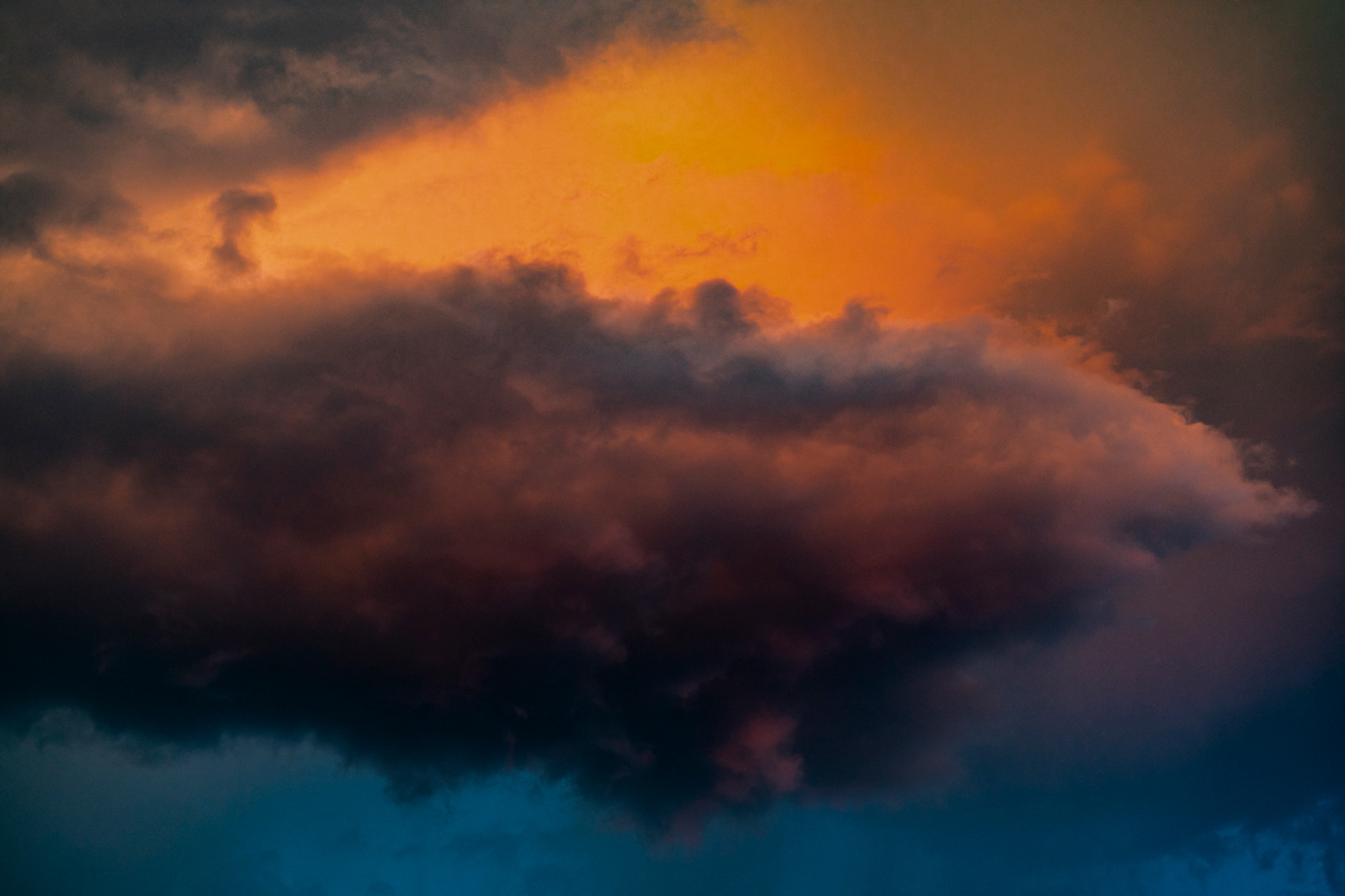
Many parts of the Southwest experienced consistently stronger monsoon activity as well. The next image was taken in the desert northeast of Prescott (AZ) at Arco Santi, a 1950’s architectural experiment in designing cities that minimized impact on surrounding natural areas, in this case, a stretch of untouched high desert. It is rare to see this site without clear blue skies overhead.
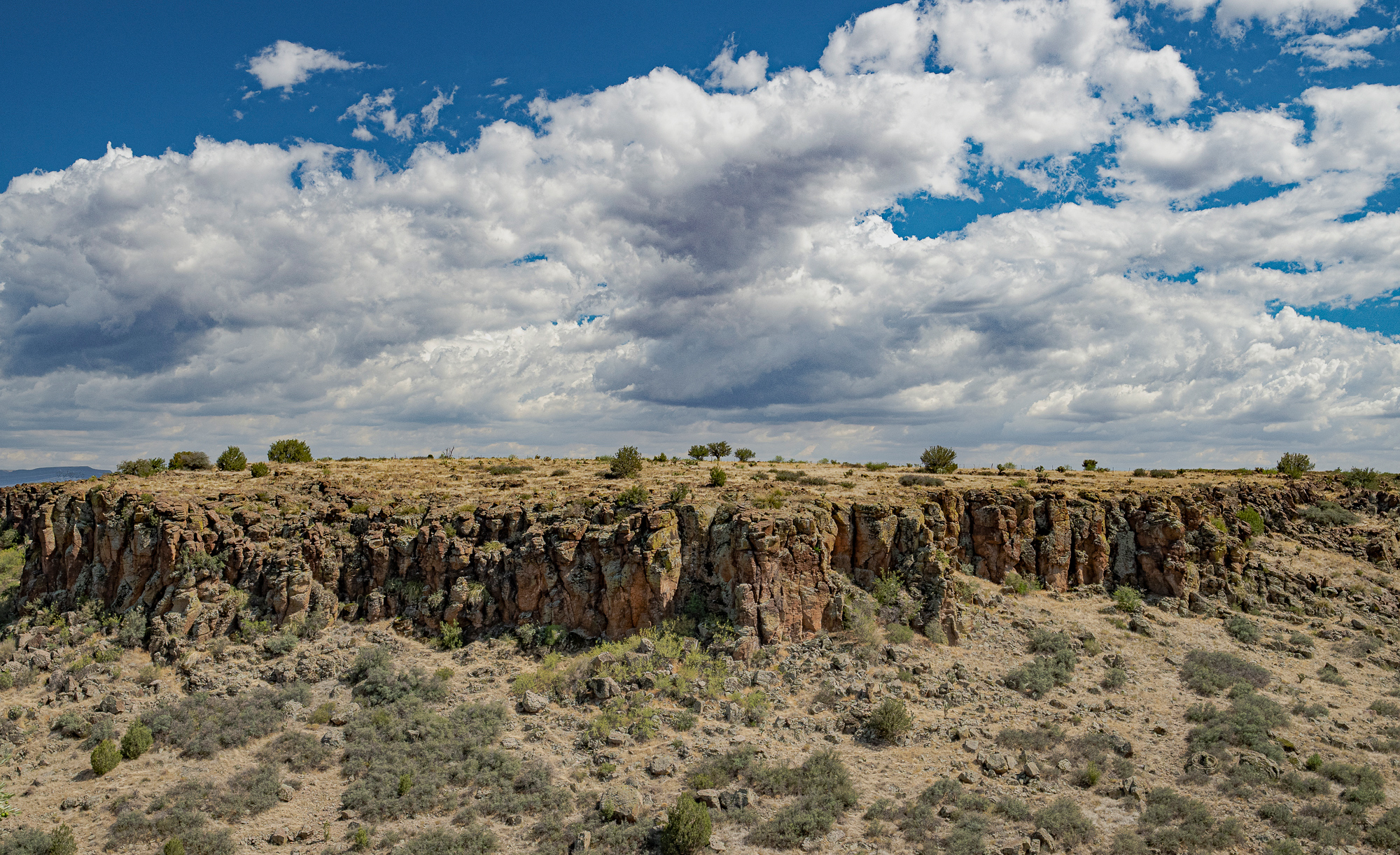
While visiting friends and family in Colorado the first week of July, I had the opportunity to observe monsoon activity in Colorado Springs and in the mountains surrounding Dillon west of Denver. The skies above Garden of the Gods in Colorado Springs looked as dynamic as those of northern Arizona despite being 650 miles away to the northeast.
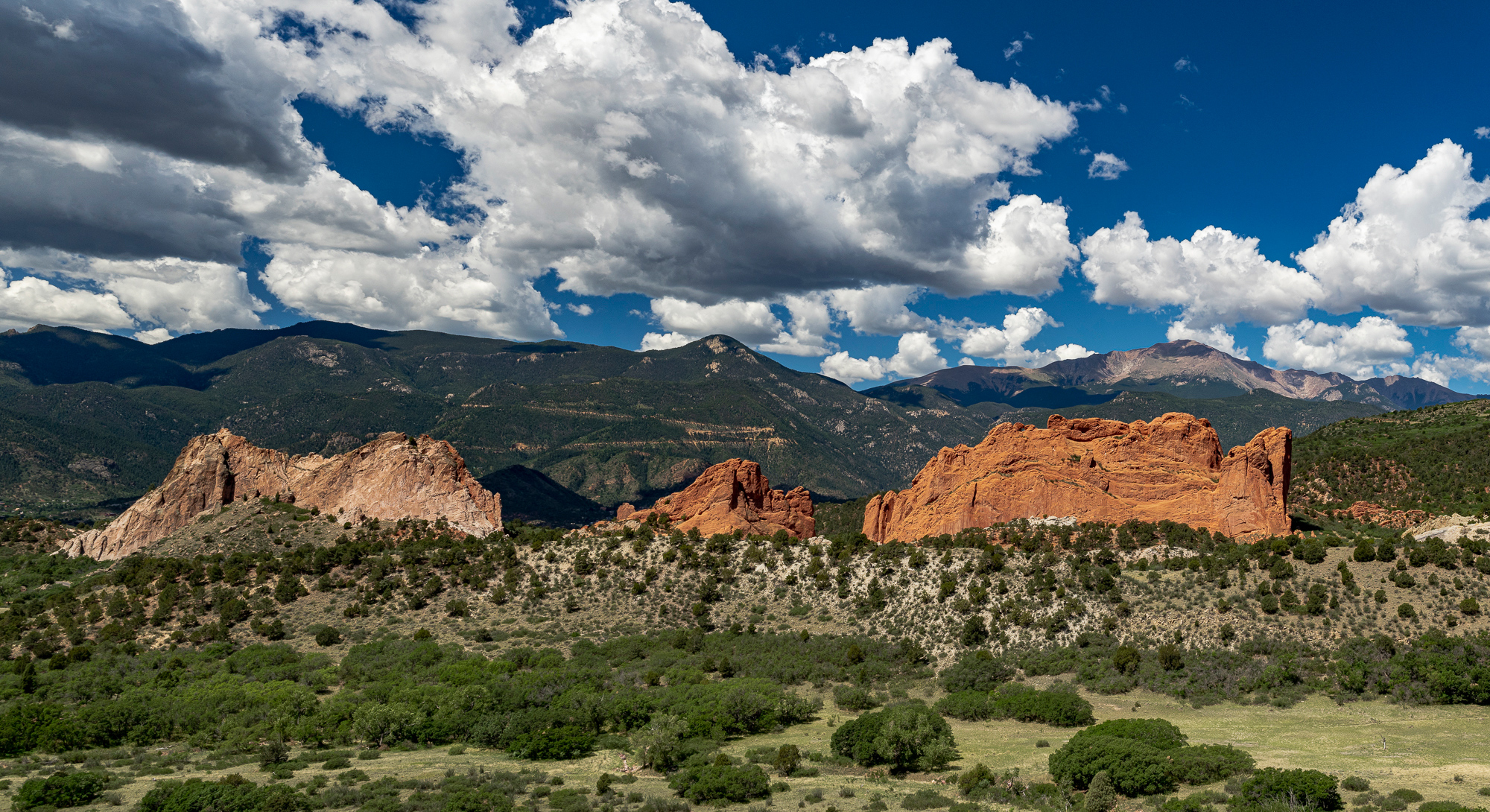
Though these two landmarks are spectacular any time of year, these clouds do make the scene more dynamic than usual. (The red rock formation on the right is known as “Kissing Camels”, and I will be looking at it and at Pike’s Peak beyond it every day after June 2023 when my wife and I move to our new home opposite Garden of the Gods.)
The skies over Lake Dillon and the town of Dillon were equally striking. This beautiful mountain town along I-70 is a short distance from six ski resorts in Colorado, and one hour from Denver. Friends that we visited there gave us a first-class tour of the area. Over the years I skied 17 of the 18 major ski resorts in Colorado and knew this area well. But it was so much better to see it through their eyes.
The next two images are of Lake Dillon and the surrounding mountains.
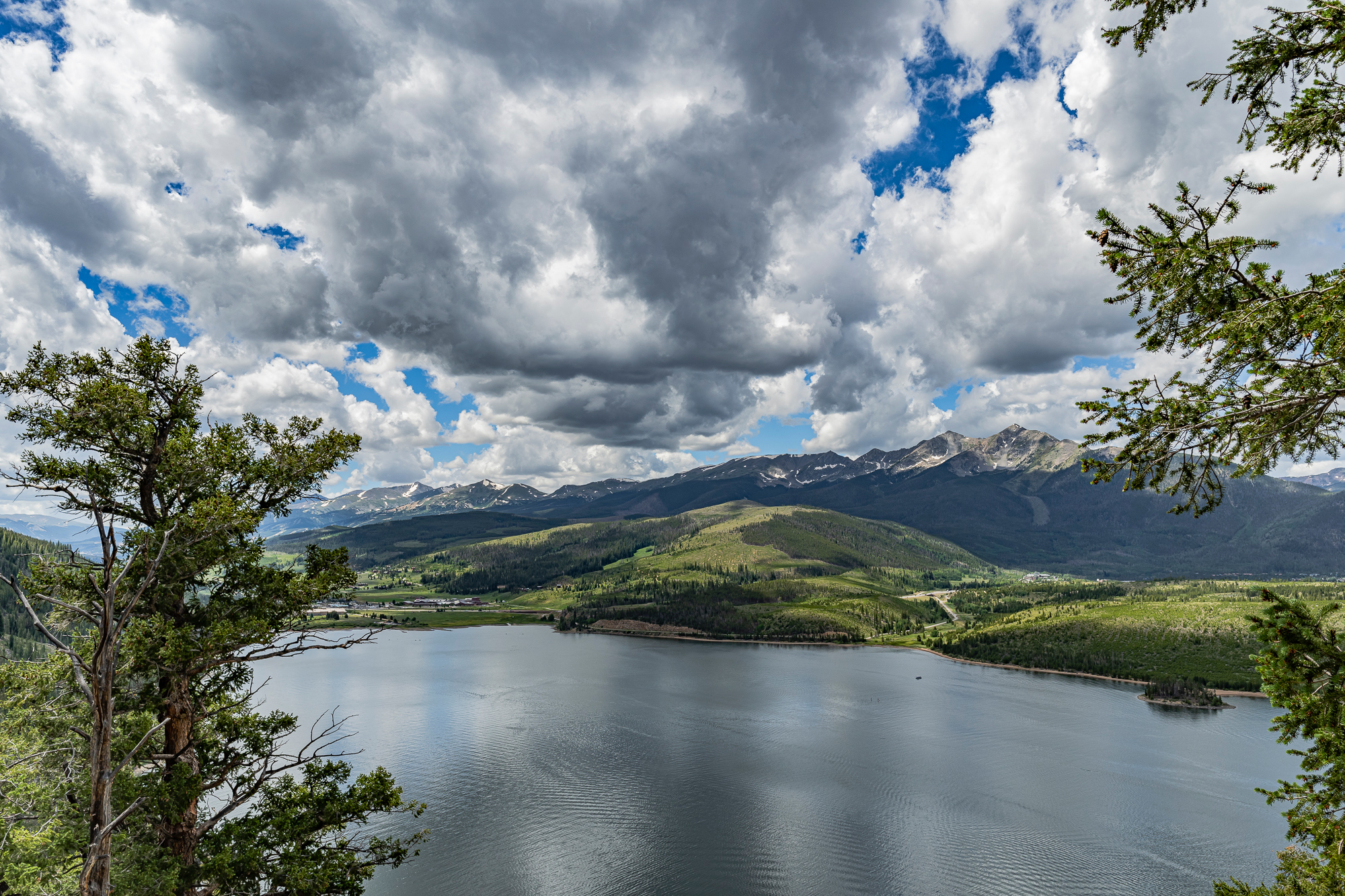
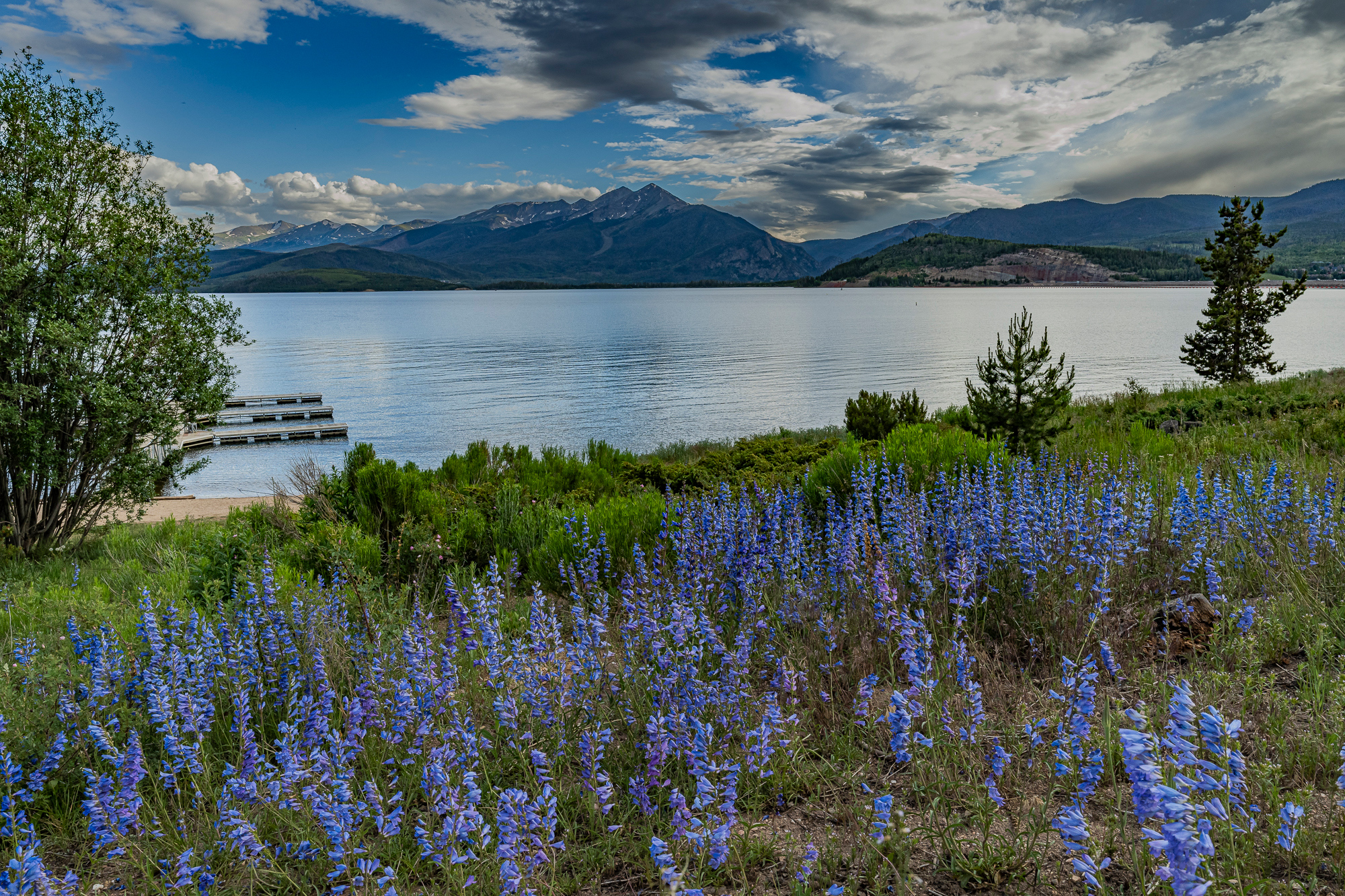
While hiking around Lake Dillon I was particularly impressed with the unusually crisp appearance of the clouds. At 10,000 feet the air holds less moisture, and the scenes are clearer. At that point my focus shifted to making images that fully captured the qualities of these clouds moving through the high peaks. If conditions permitted, I intended to take multiple overlapping images both vertically and horizontally to be digitally stitched later in post-edit.
I got my chance that afternoon when we parked at the top of Loveland Pass at the 12,000 feet altitude marker. The wind was quite low for this location. So, it was easy to line up the overlapping shots with consistency, even though I didn’t use a tripod. My Sony A1 and Voigtlander APO-macro 50mm f2 lens did the rest.

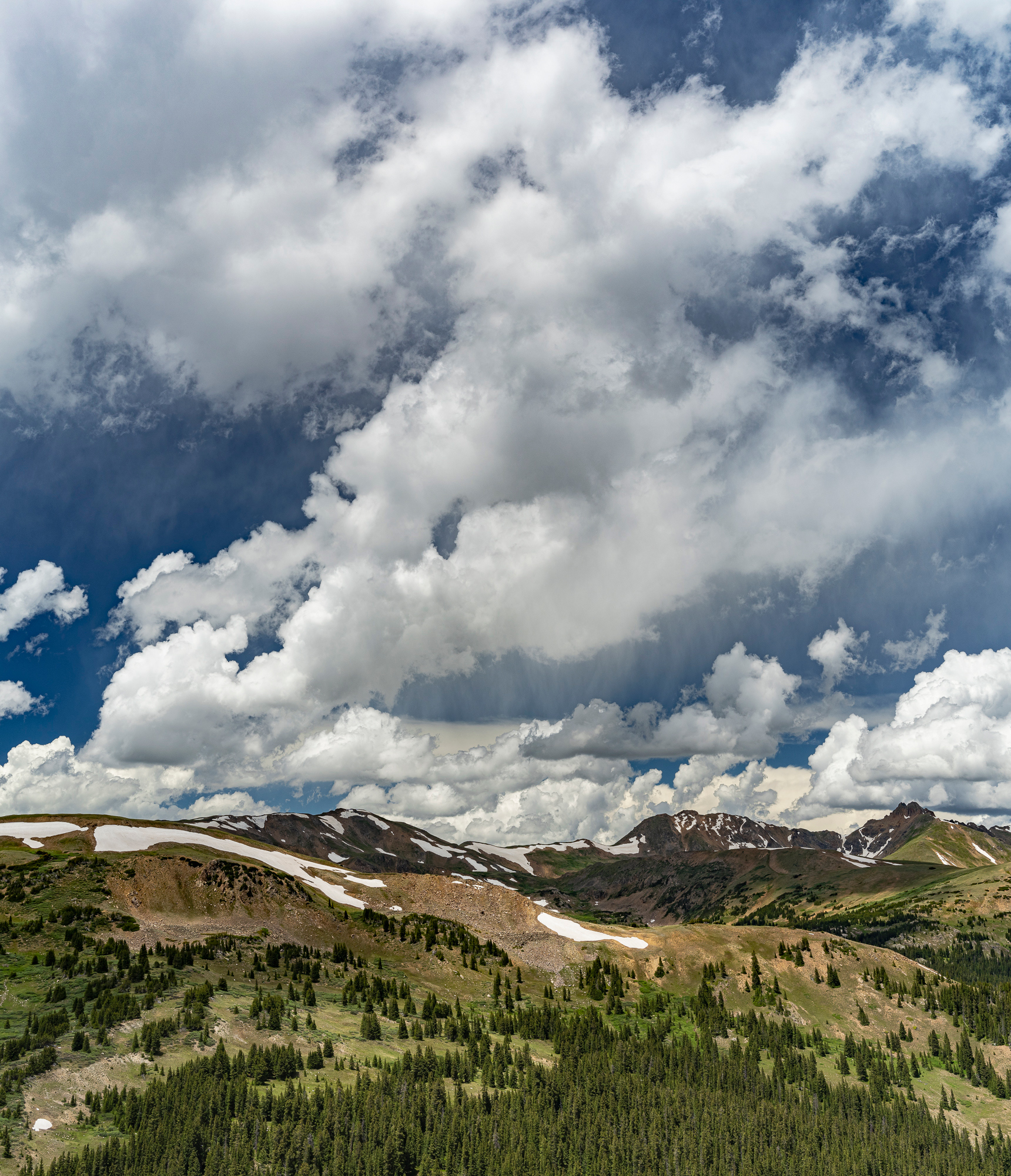
We returned to Sedona on July 8th, and I looked forward to more opportunities to capture dramatic skies. The next one came nine days later.
Photographers and artists always look to nature for beautiful, inspirational scenes to capture. We often forget that Nature involves continual change, including life, death, and rebirth as part of an evolutionary process. Inevitably, there is large-scale destruction of flora and fauna that is saddening and often ugly. Even when the cause is a natural phenomenon, we grieve to see such trauma and disruption.
In business, this process is often called “creative destruction”, a concept that applies aptly to the natural world, as it often produces something more beautiful and durable than what was destroyed. So, if we witness the first event, we grieve. But if we live long enough, we may ultimately rejoice.
Monsoon storms bring precious water to arid lands and revive stressed forests. However, there is a destructive side. In the American Southwest, large monsoon clouds also produce lightning that strikes one or several trees engulfing them in flame. How fast and how far the initial small fires spread depends on how dry the trees and brush are. Generally, they dry out by late June. In drought years, they essentially become tinder by the start of the monsoon season and can develop into firestorms that incinerate thousands of acres of bone-dry woodlands. I have witnessed and photographed three major forest fires in the Sedona area over the last 20 years. It was hard to watch, though I have also seen these destroyed areas recover beautifully.
On July 17th, 2022, I watched lightning strike the top of Munds Mountain on the Mogollon Rim, an area that I have photographed hundreds of times. The resulting fire spread quickly, and I had visions of one of the most beautiful scenes in Sedona turning into a black wasteland. Nevertheless, the only thing I could do was photograph it. The images are dramatic, though anything but beautiful. They do serve a purpose, which is to remind us that nothing stays the same. But in the long run, there is potential for something as good or even greater.
The following three images were made between late afternoon and one hour after sunset when the wind shifted direction and revealed the flames in different parts of the west-facing flank of Munds Mountain.
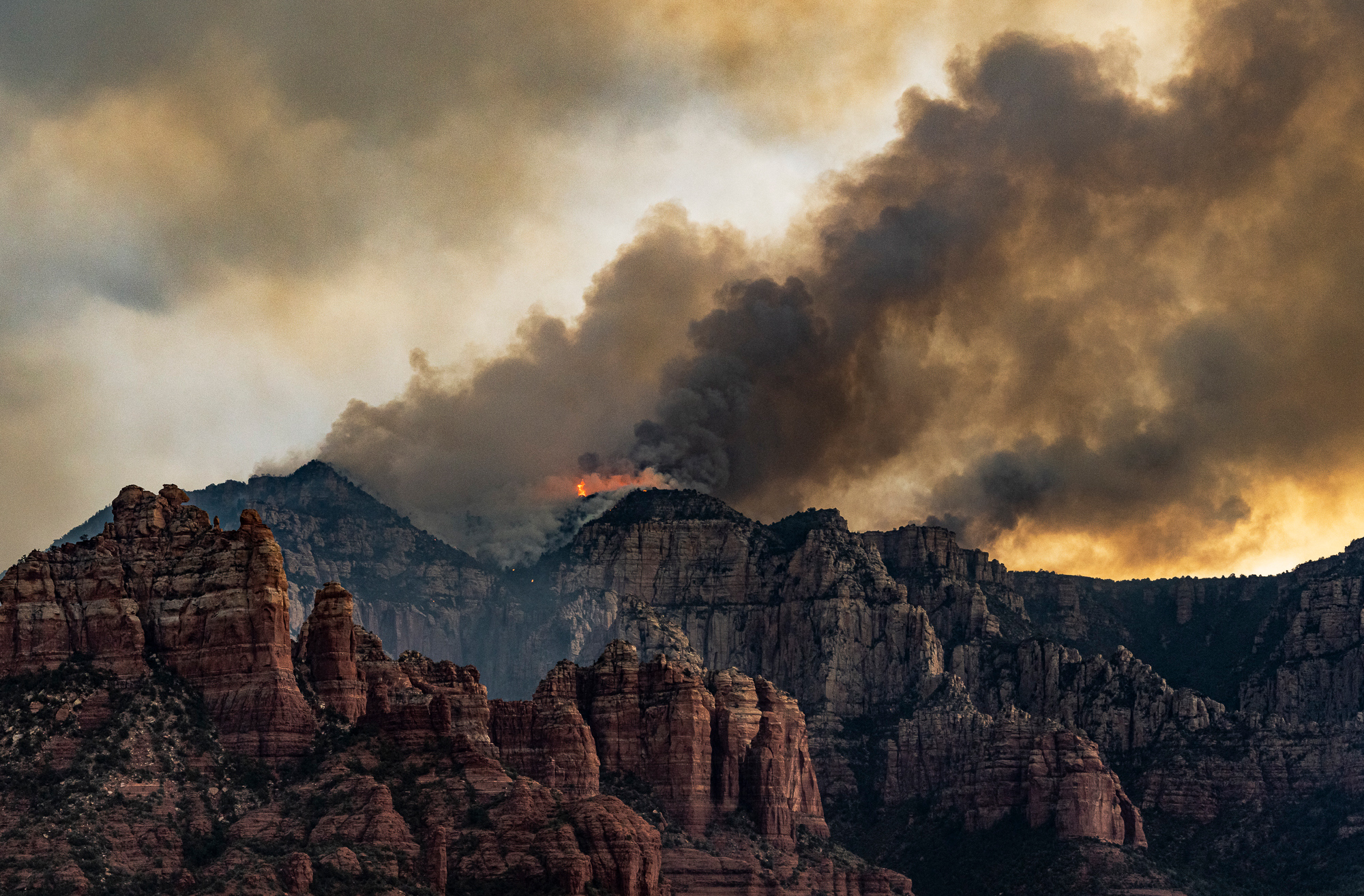
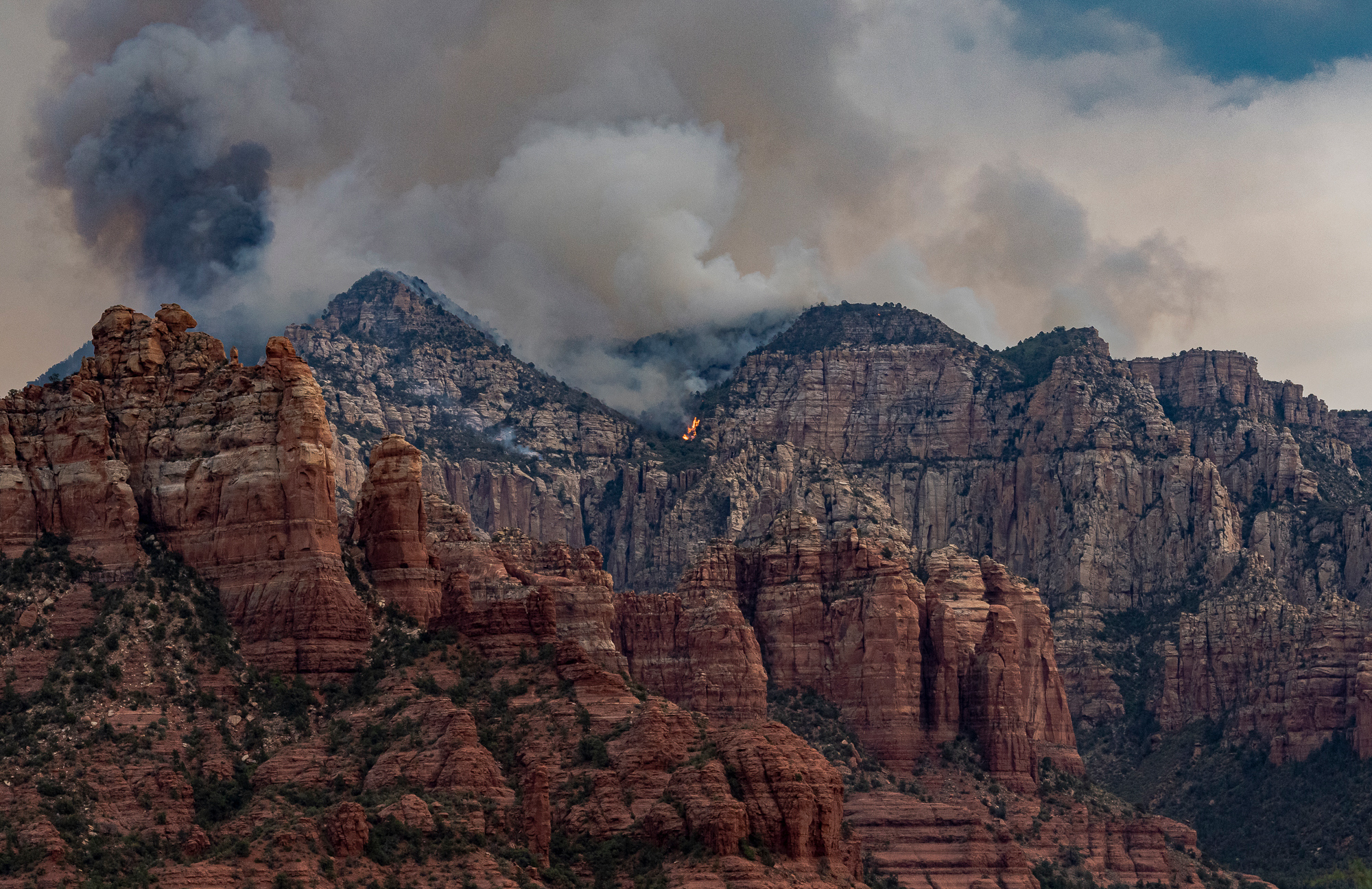
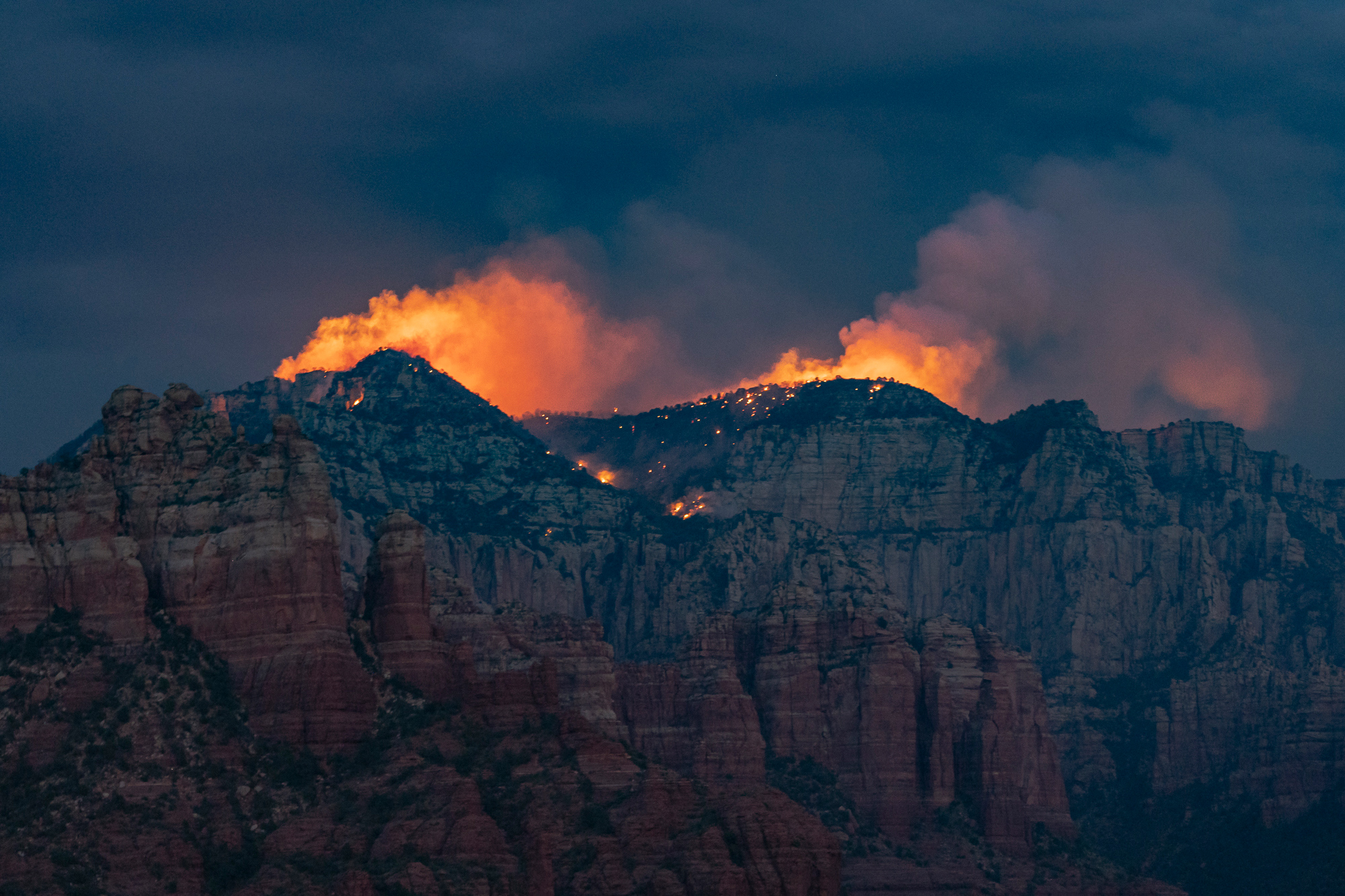
(Insert caption): Darkness reveals hot spots & extent of fire spread at Munds Mt
As it turned out, the firefighting teams did a masterful job of keeping the fire confined to the mountain and letting it burn within a steep natural bowl bounded by bare rock. After two or three days, flames were only visible in small areas when the wind picked up, though there were numerous smoldering hot spots in the bowl. Within a week, the fire burned itself out, and from a distance, the charred area was barely distinguishable from the normal dark vegetation covering adjoining areas. Soon afterward I once more photographed the Munds Mountain Wilderness with the full measure of awe and gratitude.
In the weeks that followed, incoming monsoon clouds kept soaking the forests and also produced several rainbows, as if to reassure Nature-lovers that the worst was over, at least for a year. The next two images captured rainbows in chaotic and complex skies.
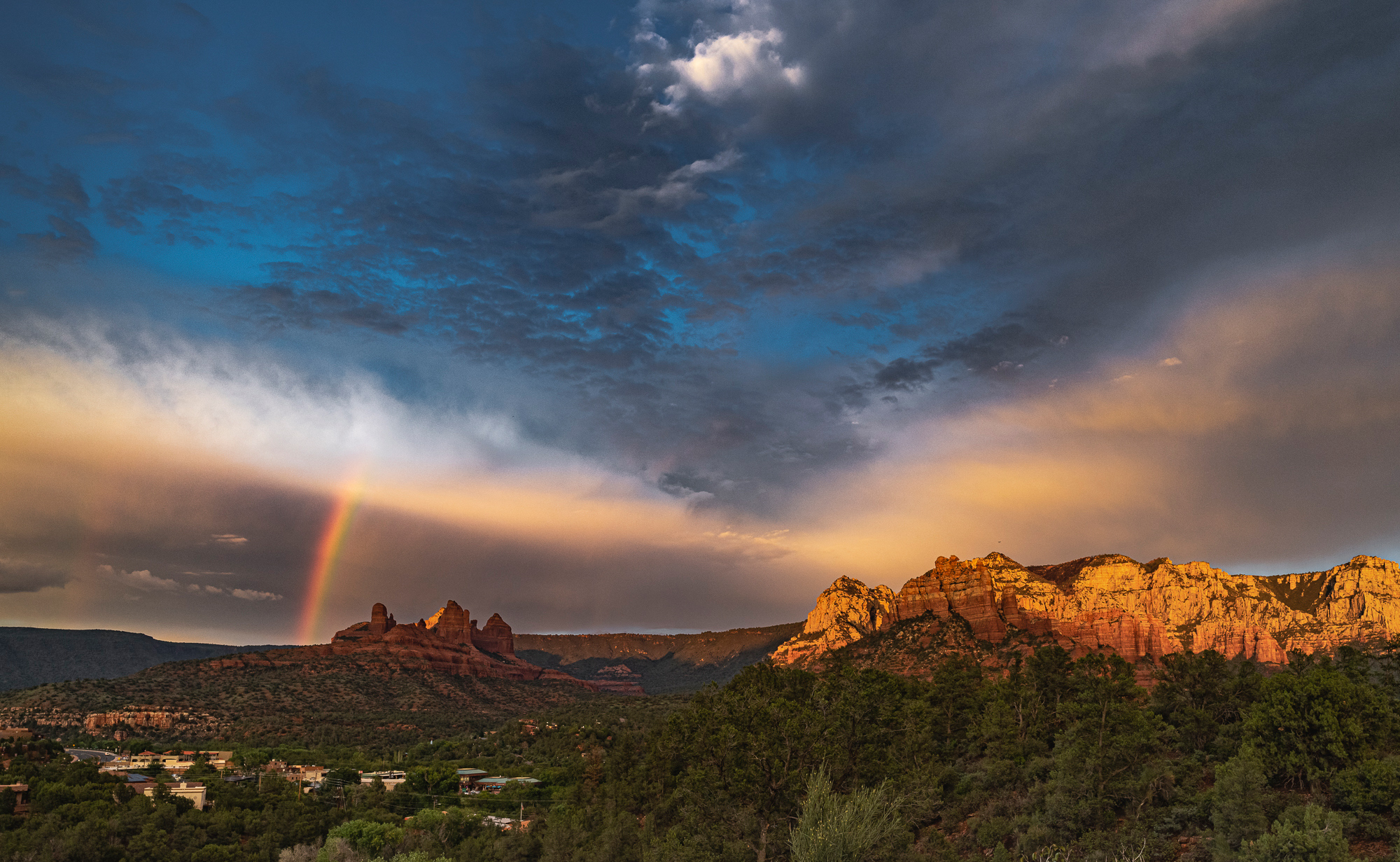
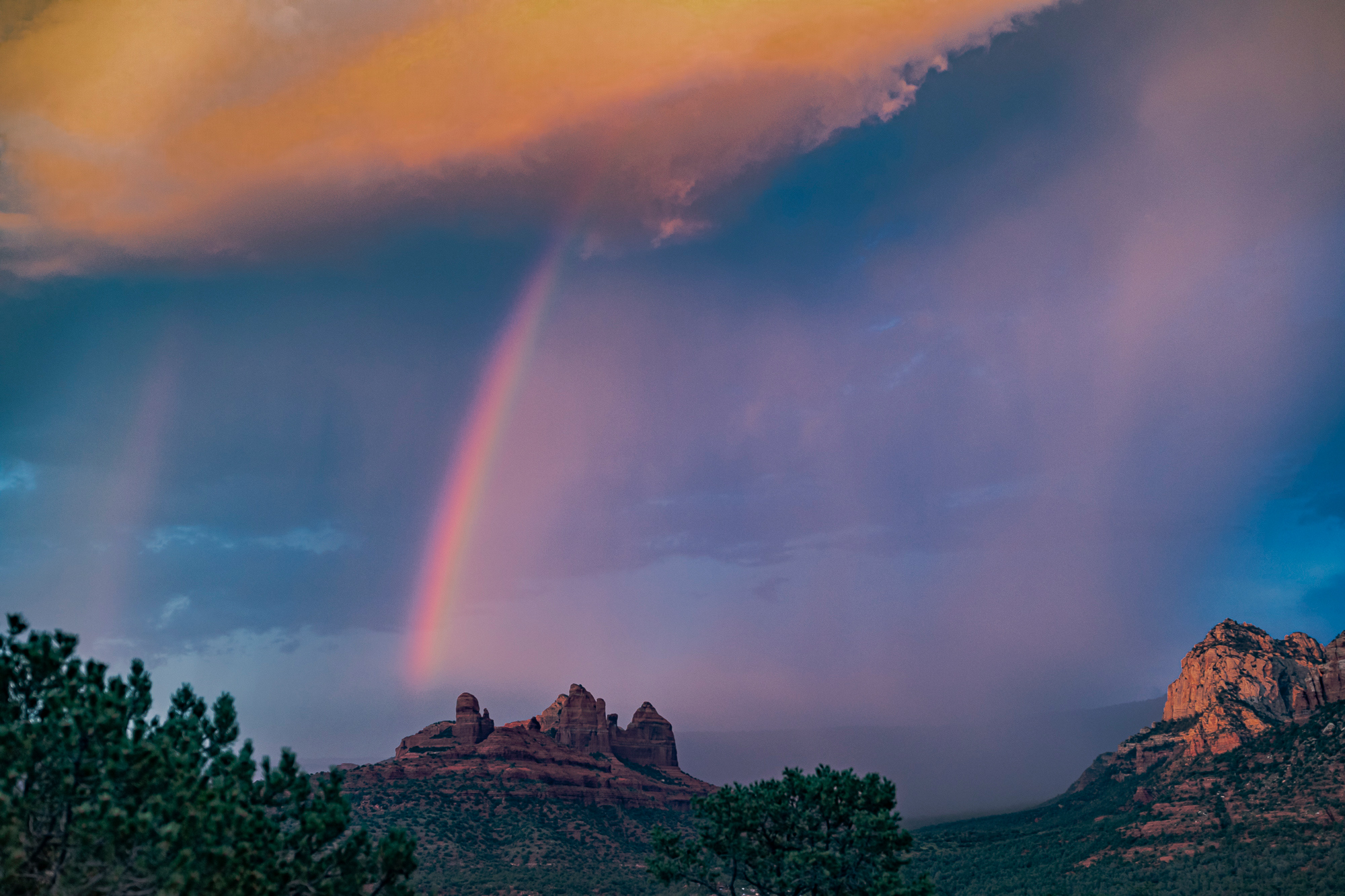
As the Monsoon Season moved into September, the thunderstorms formed later in the afternoons and closer to sunset. This timing produced several rainbows amid clouds that glowed red in the setting sun. The best one caught me unprepared. As I ran to get my camera, I realized that this unusual rainbow would likely disappear before I was ready to shoot.
So, I asked my wife to photograph it on her phone. She recorded a rare image while I was still grabbing my gear. As an artist, she really knows how to frame a scene.
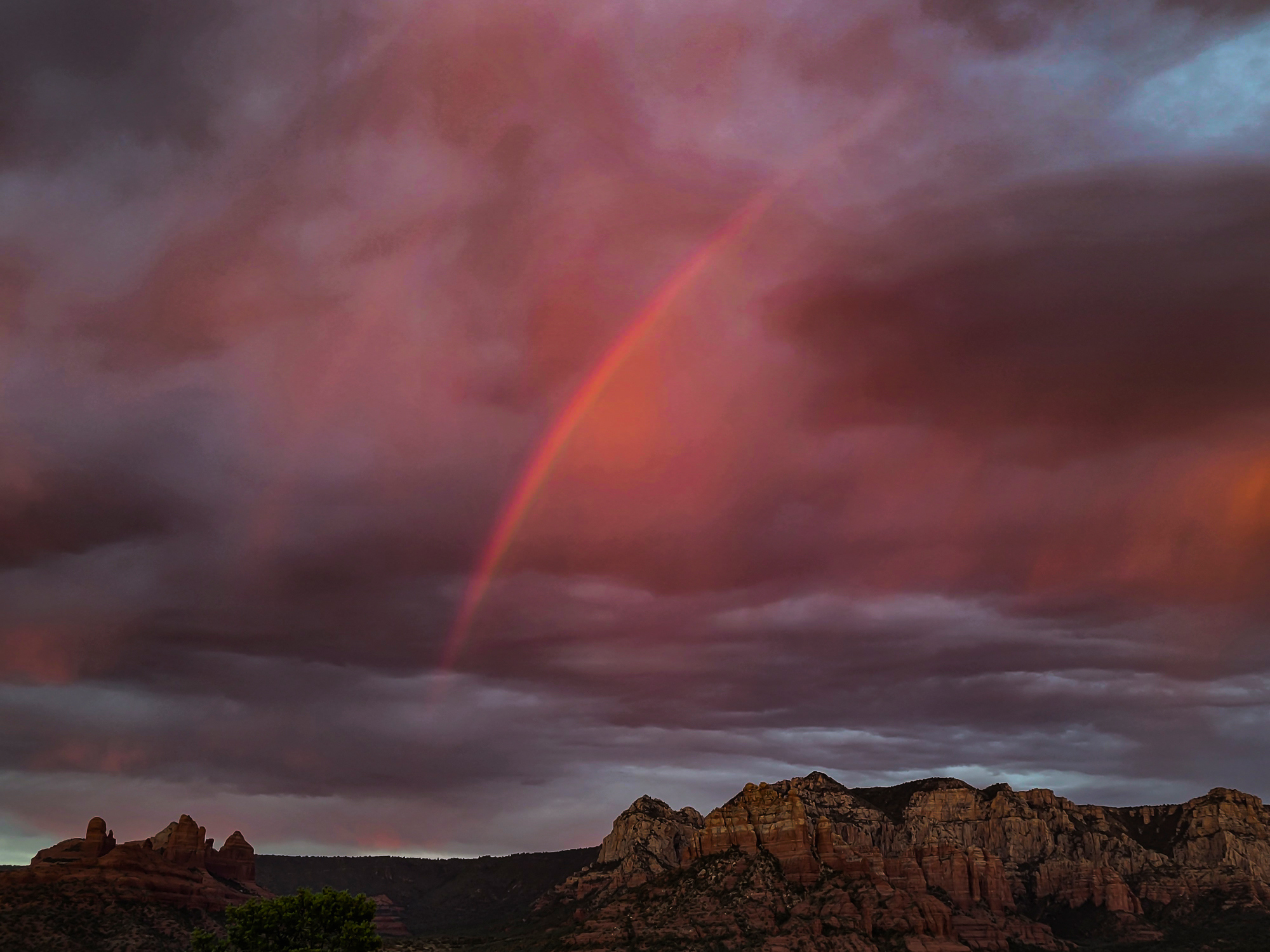
Post Logue
I finished writing this article on September 23rd in large part because I thought the Monsoon Season was tapering off and would end within a week. This has been the pattern for the past 20 years. However, this year was unlike the previous nineteen. This year, storms were more frequent and produced more rain than any year that I’ve observed.
Therefore, it should have been no surprise that this 2022 Monsoon Season would last longer. But I was pleasantly surprised while in Colorado from September 28th to October 3rd. The rains kept coming and produced some dramatic images a few of which are shown below.
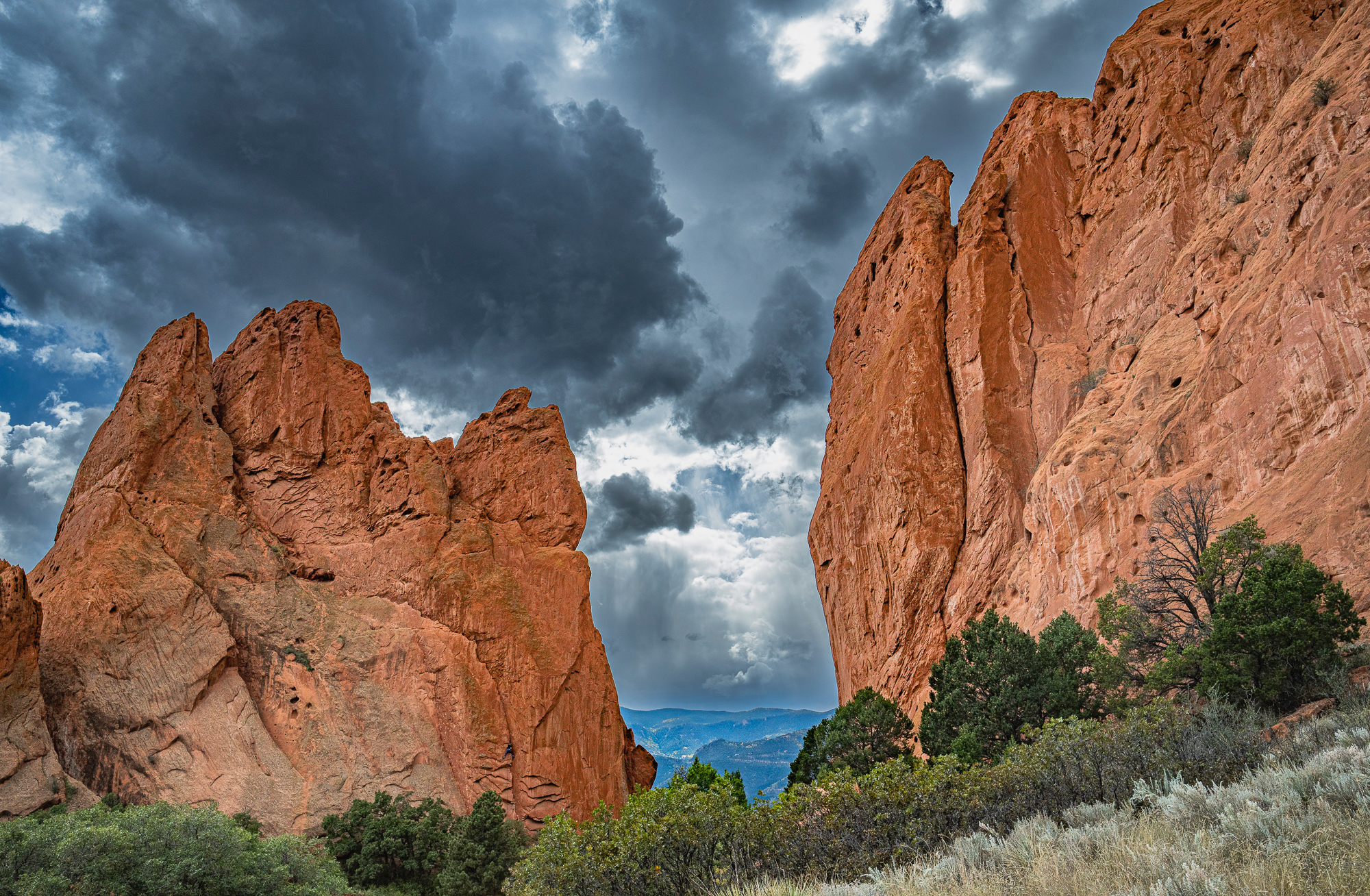
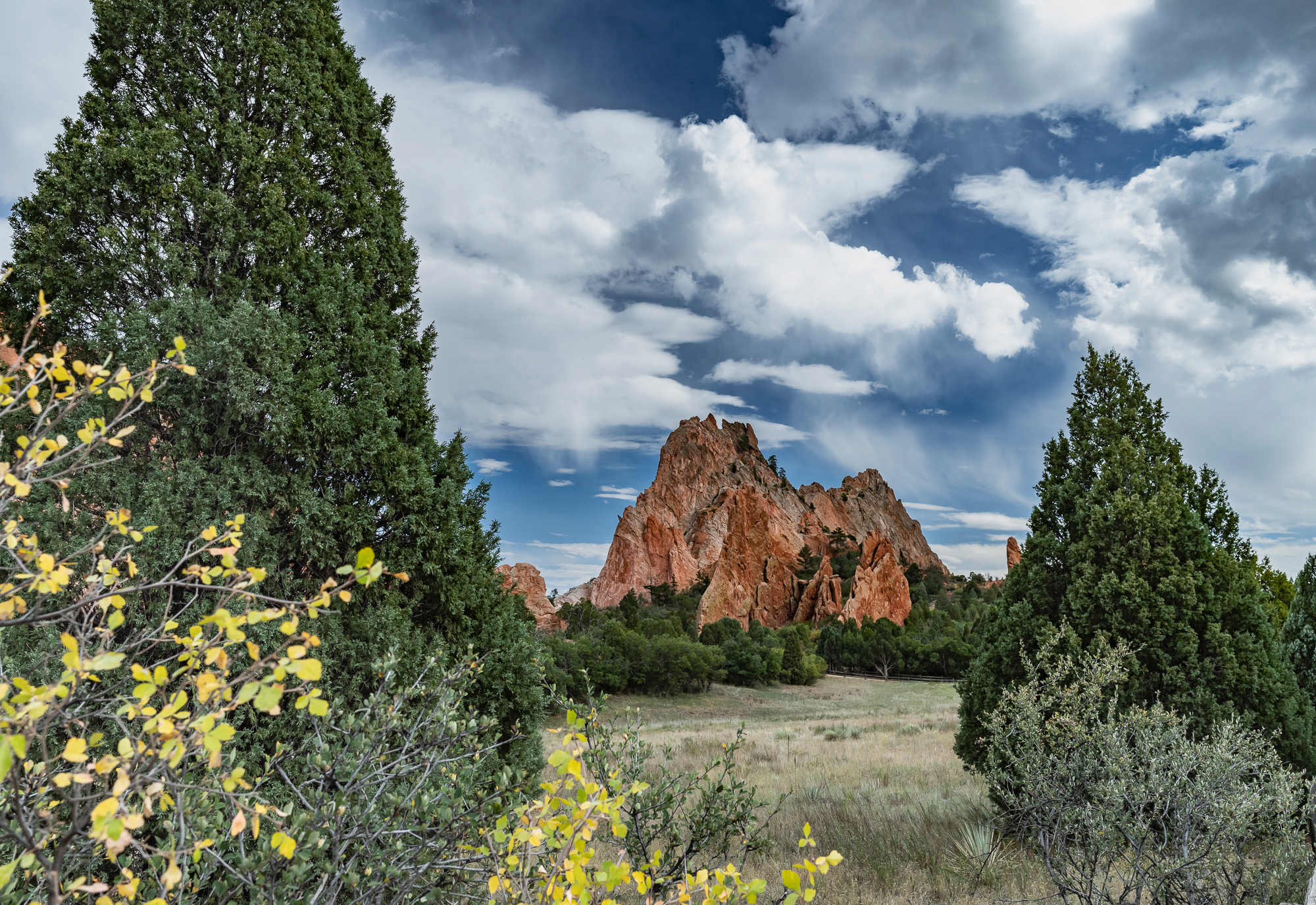
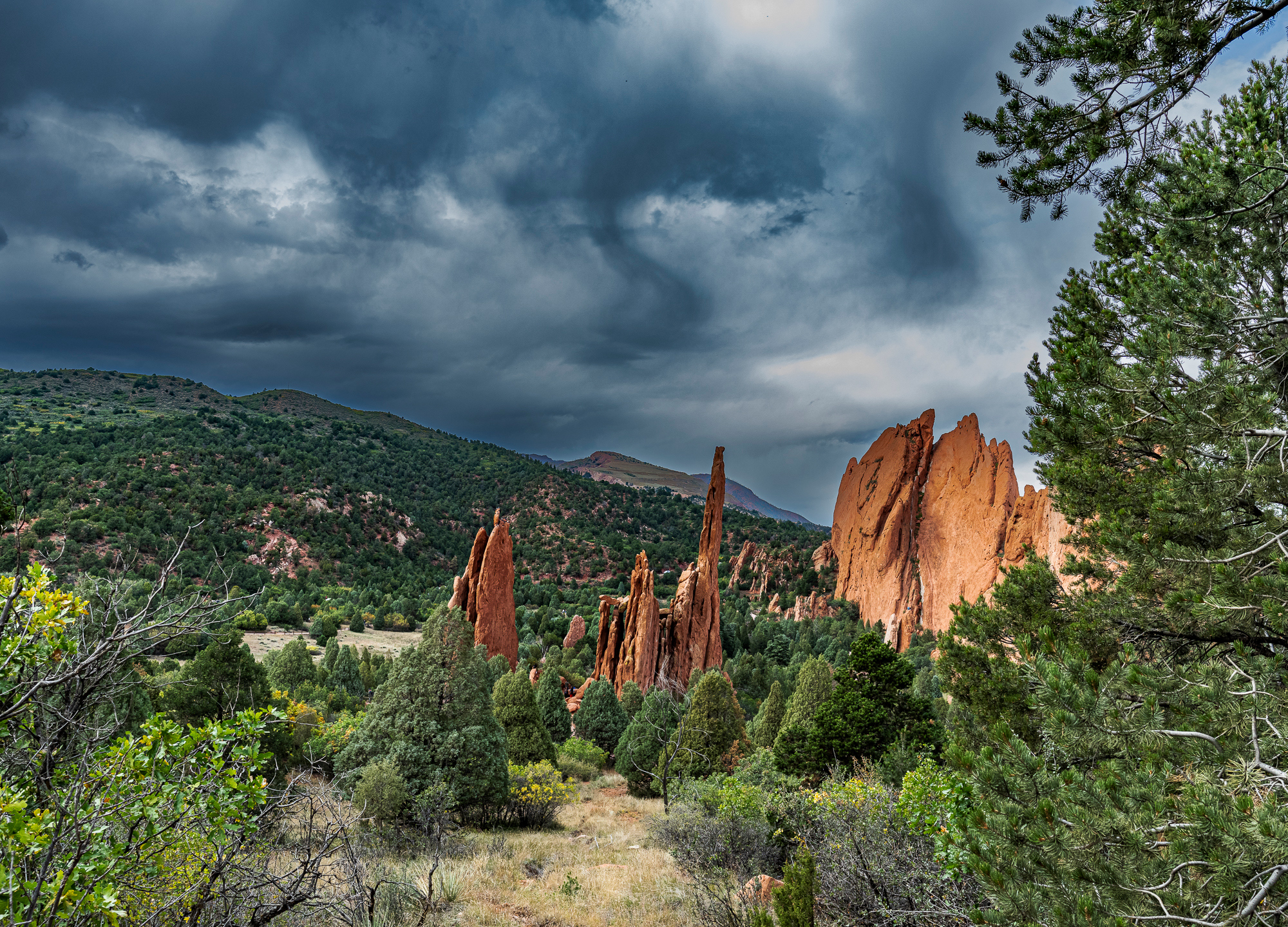
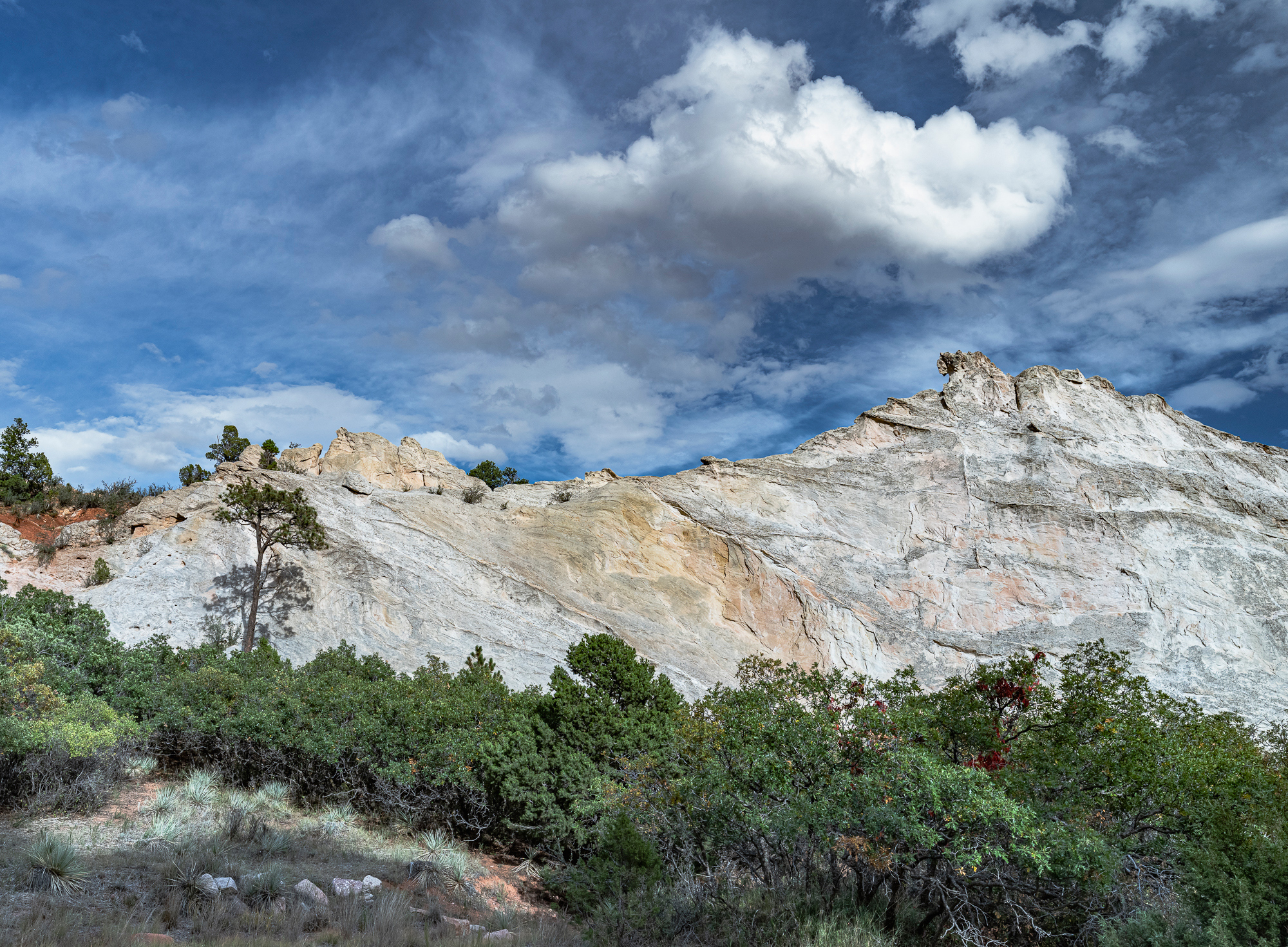
The rain continued throughout our homeward drive. On our last day driving, we left Durango, CO, and stopped for an early dinner at the Cameron Trading Post on Route 89. Once there we were told about a 5-car fatal accident that took place just north of Flagstaff during a heavy downpour. The wreckage was cleared away by the time we reached that location. In its place was a brilliant rainbow that “anchored” just across the road from us, a fitting sign that the tempest had passed.
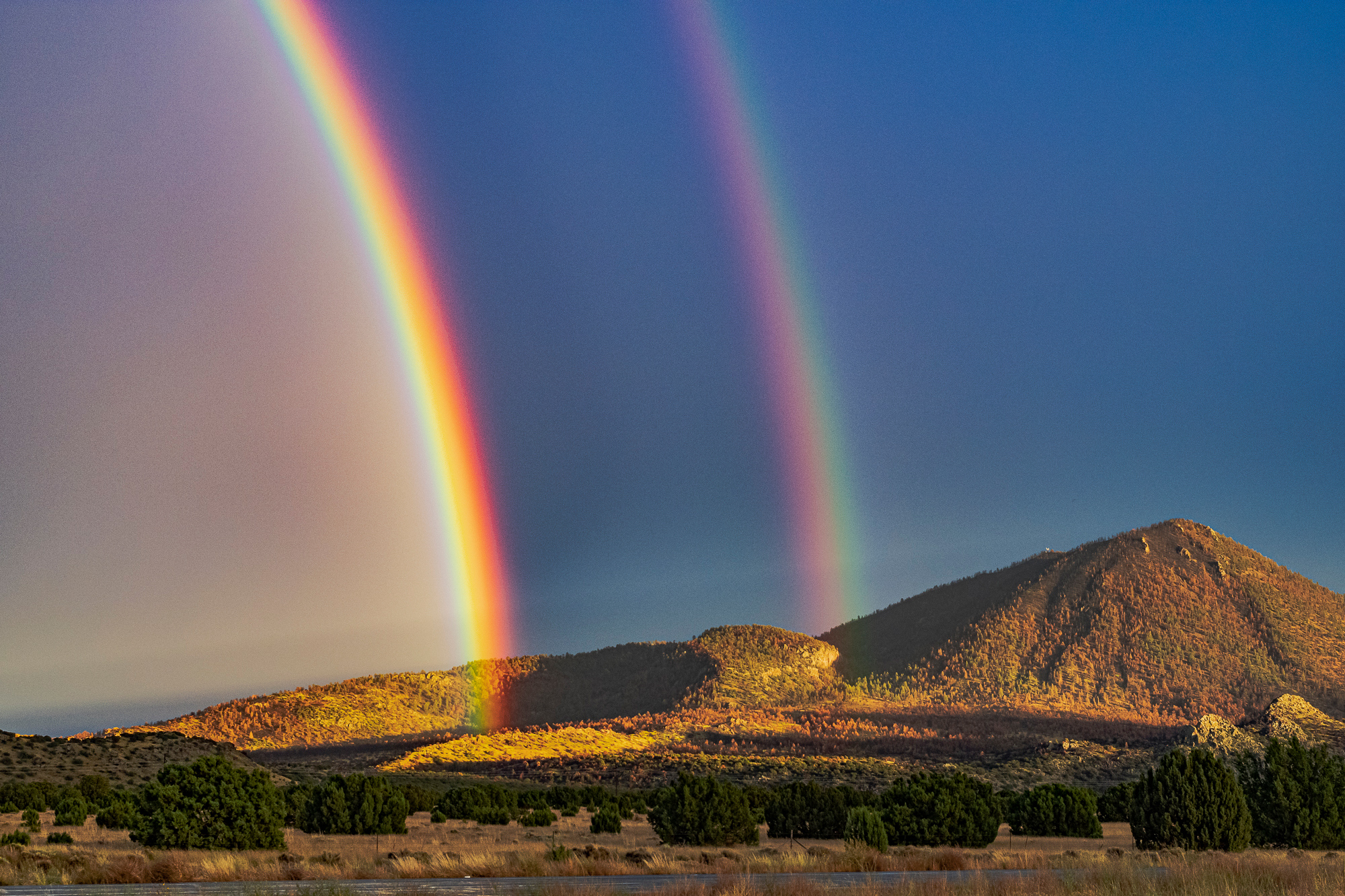
Harvey Stearn
October 2022
Sedona, AZ
To see the scope and essence of Harvey Stearn's photographic art please visit www.CameraStops.com. Mr. Stearn began photographing Western landscapes and wildlife at the age of 13, spent 50 years pursuing his passion in the field and in the darkroom before fully converting to digital photography in 2002. He developed color prints as well as monochrome, but switched over to digital capture and editing in 2002. Though he was a top executive for two large scale land development and home building corporations, he always found time for his fine art photography which won many awards. His work was exhibited in art museums in Southern California and Arizona, and was also featured in billboard advertisements and published in magazines. Mr. Stearn served on the California Arts Council for nine years, including two years as Chairman and another two as Vice Chairman. In addition, he was the founding Chairman of the John Wayne Airport Arts Commission in Orange County, California. Mr. Stearn’s work was sold through Arizona galleries for 15 years. In recent years he wrote 33 illustrated articles for PhotoPXL.com and 14 articles for Luminous-Landscape.com. In 2013 he published a book entitled “In Search of the Old West” which has been widely acclaimed. He was a guest lecturer on photography on a cruise ship visiting Chile, Argentina, Uruguay and the Falkland Islands. His work was among the top 100 images printed in NANPA's Showcase publications in 2019 and 2020. Images have been edited and selected for two new books on Landscape photography which will be published in late 2024 and early 2025.






